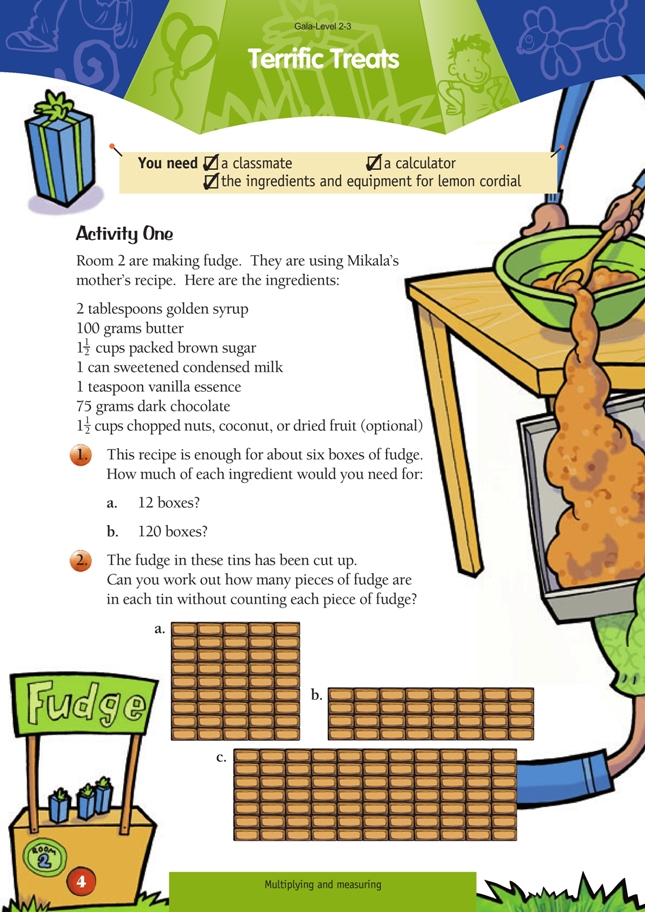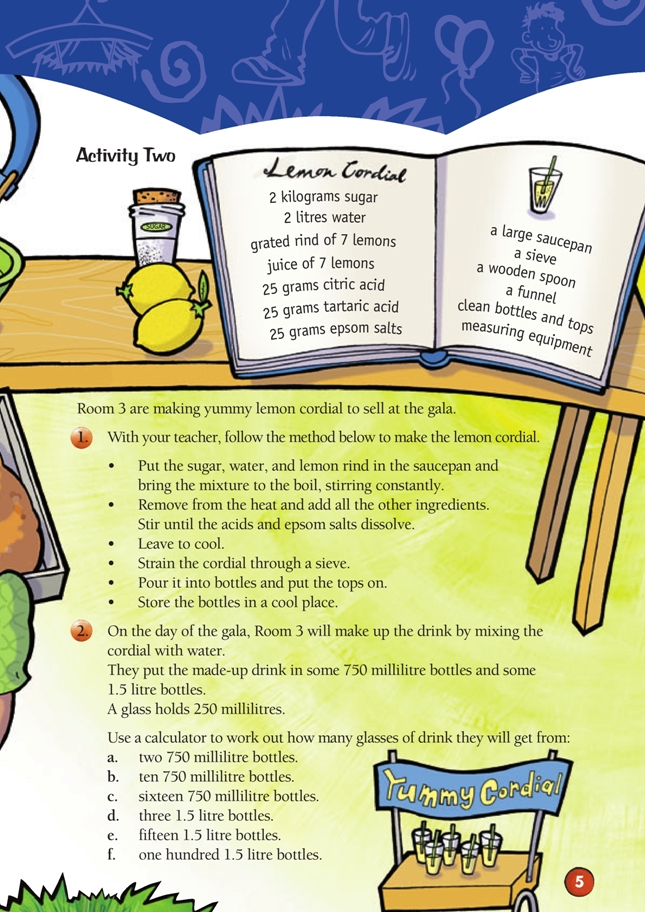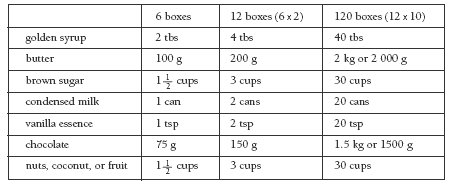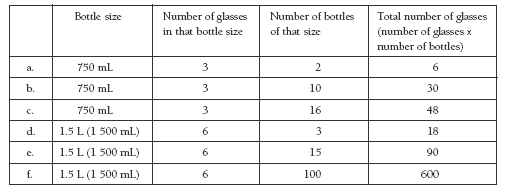This is a level 3 number and measurement activity from the Figure It Out theme series.
A PDF of the student activity is included.
Click on the image to enlarge it. Click again to close. Download PDF (569 KB)
multiply by multiples of 10
use multiplicatin facts to solve problems
use a calculator to solve capacity calculation problems
A classmate
A calculator
Ingredients and equipment for lemon cordial (list available in Student book)
Activity One
The students could do this activity in small groups. They will need to see the relationship between the amounts of ingredients in the recipe and the number of boxes: 6, 12 (6 x 2), and 120 (12 x 10 or 6 x 20). The students could summarise their results in a table.
For question 2, the students may be able to use their knowledge of basic facts to mentally interpret the array patterns. For example, they may know that 4 rows of 8 is the multiplication fact 4 x 8 = 32. If they don’t know that, they may know 4 x 4 and recognise question 2b as double that. Encourage the students to make links to known facts by marking off parts of the array pattern they already know. Alternatively, they may mentally use repeated addition of the rows, which gives the multiples of 8: 8, 16, 24, 32, or the columns, which gives the multiples of 4: 4, 8, 12, 16, 20, 24, 28, 32.
As an extension, the students could:
• investigate other numbers up to 50 that would make rectangles suitable for fudge tins
• survey their classmates to find out whether nuts, coconut, or dried fruit is the most popular addition to fudge
• find out how much it costs to make 6, 12, and 120 boxes of fudge and suggest a charge per box. This assumes that no ingredients were donated.
Activity Two
This activity gives the students good experience in using equipment to measure accurately and in using measuring language. Discuss the quantities needed with the students and work through the recipe step by step. They may need to measure 25 grams by dividing up a larger quantity weighed on the kitchen scales.
You will need to explain the relationship between millilitres and litres before the students set about solving question 2.
Some students may need support or hints with aspects of this task, such as:
• understanding the question
• deciding which operation is appropriate
• changing litres to millilitres (for example, converting 1.5 litres to 1500 millilitres)
• seeing that 1.5 litres is double 750 millilitres.
You could begin by working with the students to find out how many glasses there are in a 750 millilitre bottle and in a 1.5 litre bottle. A table is an excellent way to record results systematically. For example:
If the students record their results systematically, they may be able to figure out how to combine their answers to previous questions to answer later questions. For example, the answer to 2b is 5 times 2a.
You could extend the activity by:
• Using the quantities in question 2 to work with fractions. For example, “What fraction of a small bottle is a glass?” “What fraction of a large bottle is a glass?” “What fraction of a large bottle is three glasses?”
• Calculating the cost of making lemonade. Compare the cost with the prices for the same-sized bottle sold in a supermarket.
• Finding out how much of the solution needs to be mixed with water for best-tasting cordial. Calculate how much undiluted cordial would be needed for each part of question 2.
Answers to Activities
Activity One
1. a. The answer is found by doubling the ingredients.
4 tbsp golden syrup
200 g butter
3 cups packed brown sugar
2 cans sweetened condensed milk
2 tsp vanilla essence
150 g dark chocolate
3 cups chopped nuts, coconuts, or dried fruit (optional)
b. The answer is found by multiplying the ingredients by 20 or multiplying the
answer to 1a by 10.
40 tbsp golden syrup
2 000 g or 2 kg of butter
30 cups packed brown sugar
20 cans sweetened condensed milk
20 tsp vanilla essence
1 500 g or 1 kg dark chocolate
30 cups chopped nuts, coconut, or dried fruit (optional)
2. a. 5 x 9 = 45
b. 4 x 8 = 32
c. 7 x 11 = 77
Activity Two
1. Practical activity
2. a. 6 glasses
b. 30 glasses
c. 48 glasses
d. 18 glasses
e. 90 glasses
f. 600 glasses



